Project Log: Friday, July 13, 2012
The day's first order of business was to move the masts
back outdoors; I'd left them in the shop all week.
Moving the masts out was easier than bringing them in
had been, since now the paint was cured enough to
handle. I set the spars outside on sawhorses
covered with cloths to protect the paint from
inadvertent damage. |
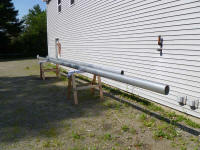 |
I'd been thinking of starting the new structural work in
the cockpit, but didn't have plastic sheeting on hand
that I needed to wrap up the interior and other parts of
the boat against the dust this work would create, so I
postponed that project yet again. Obviously I
didn't really want to do that job, but I couldn't push
it off much longer.
I pulled out the rudder feedback sensor required for the
autopilot, with ideas of working on its installation.
While I didn't expect the installation to be difficult,
I discovered that to secure the transmitter rod to the
steering arm I'd need a metric tap that I didn't have,
so I made a note to order one and moved in another
direction.
After much thought and consideration during earlier days
spent working on the diesel heating system, I'd settled
on a route for the final hoses, which needed to run from
the fan heater in the pilothouse to the one in the
saloon, and then return to tee into the system at the
aft end of the engine room. The only way to run
the hose between the fan heaters was to lead it down
through the helm console and then through the main
bulkhead and into the dinette cabinetry, where I could
then lead the hose to the fan heater located in the
center of the dinette.
Taking into account various other installations and
obstructions, I determined where to drill the hole
through the console and into the utility space outboard
of the engine room on the port side. Then, I led a
3/4" hose through the new opening, adding a length of
larger hose as chafing gear and also as a bend radius
limiter (to avoid kinking the heating hose). I led
one end of this hose aft, securing it along the way to
the inside of the cabinet, and connected it to the
outlet side of the pilothouse fan heater. Here, I
also clipped an aquastat sensor to the line, which, once
wired up, would prevent the fan heater from blowing air
till the water temperature reached a pre-set point
(about 120°, I think). |
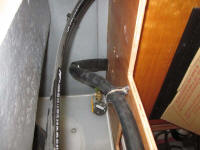
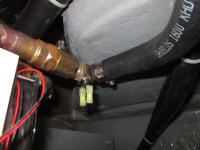
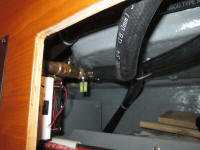 |
I led the other end of the hose down through the bottom
of the console, through another length of chafing gear,
and down towards the lower corner of the engine room,
where I'd locate the through holes to lead this hose
(and the heater return) into the dinette. |
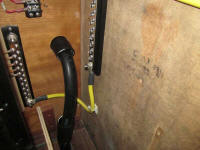 |
I made a few measurements, then from inside the dinette
used a hole saw to cut two holes large enough for the
1-1/2" ID rubber hose that I was using as chafe gear and
conduit for the heater hose. Similarly, I cut an
additional pair of holes through the bulkhead dividing
the locker space beneath the dinette, allowing me to run
two lengths of the large hose through the entire area,
creating a protective conduit for the heater hose
within. Before continuing, I coated the new cuts
inside these holes with epoxy, which conveniently
coincided with lunch break; in the warm weather the
epoxy would cure enough to allow me to continue
afterwards.
|

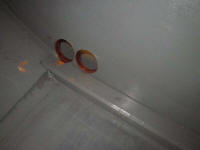
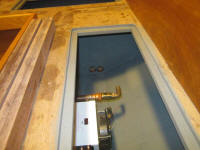 |
Later, I inserted the two lengths of 1-1/2" hose, then
ran the supply line from the dinette back to the engine
room, where I connected it to the hose leading from the
pilothouse fan heater through an elbow. Then, I
led the return line through the other conduit,
eventually securing it along the port side of the engine
room on its way aft to its final connection back to the
other side of the system. (That summer valve is
crooked and driving me crazy...I'd have to fix that
soon.) |

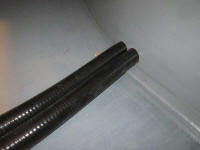
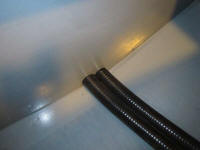
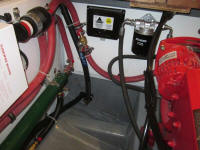
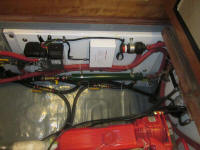
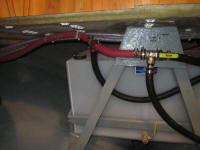
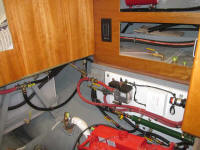
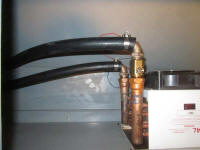
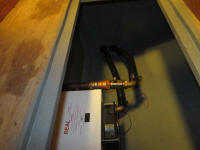 |
This completed the hose runs for the heating system.
Still ahead, I'd need to deal with the air intake and
boiler exhaust, complete the fuel line, and install all
the wiring related to the system, but it was a relief to
have the major hose runs complete. |
 |
Next, I ran the fuel supply and return lines from the
port tank, which were the longest lines required and
also the final hoses I'd need to run in and out of the
port utility space next to the engine room. Some
time ago, I'd prepared ahead for this (and other) hose
runs by preinstalling wire tie mounts beneath the
cockpit deck, so running the pair of hoses was
relatively straightforward. Where the hoses exited
from the port side to lead down beneath the cockpit, I
ran them through other lengths of hose to protect the
fuel lines from chafe. |

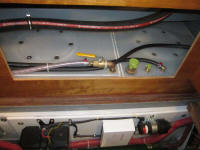
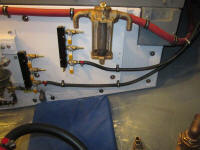
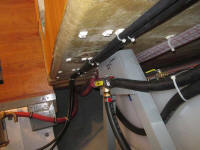 |
I would have liked to continue with some of the other
fuel lines, but the two long runs used up my supply of
5/16" fuel hose, so I'd order more and continue later. |
| |
| |
Total Time Today: 6.25 hours
|
<
Previous | Next > |
|
|























